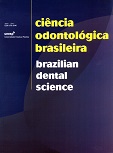Efeito de diferentes métodos de polimerização na microinfiltração marginal de restaurações de resina composta
DOI:
https://doi.org/10.14295/bds.2006.v9i2.500Abstract
RESUMOO objetivo deste trabalho foi avaliar a influência de diferentes métodos de fotopolimerização da resina composta sobre a microinfiltração marginal de restaurações de classe V em dentes bovinos. Foram realizadas 44 restaurações com a resina composta Solitaire, divididas em 4 grupos para a realização da polimerização: G1 – 100 mW/cm2 com 2 ativações de 30s cada; G2 – 200 mW/cm2 com 2 ativações de 30s cada; G3 – 600 mW/cm2 com 2 ativações de 30s cada; G4 – 100 mW/cm2 por 30s, seguida de 600 mW/cm2 por mais 30 segundos. As intensidades foram variadas por meio de tubos plásticos de 2 diferentes comprimentos acoplados à ponta do fotopolimerizador, que determinavam a quantidade de luz que chegava ao corpo-de-prova (tubo de 10cm=100 mW/cm2 e tubo de 2cm=200 mW/cm2). Após 500 ciclos térmicos (5±2°C e 55±2°C), os espécimes foram imersos em solução à base de Rodamina B por 24 horas e a microinfiltração foi avaliada. Os dados de microinfiltração dos quatro tipos de polimerização, quando submetidos ao teste de Kruskal-Wallis não diferiram estatisticamente (Esmalte: kw=3,90; gl=3; p=0,272 e Cemento: kw=4,61; gl=3; p=0,202). O teste de sinais de postos de Wilcoxon, usado para a comparação entre os dados de infiltração do esmalte frente ao cemento, em cada método de fotopolimerização, indicou uma diferença estatisticamente significante para os grupos G1, G2 e G4. Concluiu-se que os diferentes métodos de polimerização não afetaram a microinfiltração marginal de restaurações de resina composta.
Downloads
Downloads
Published
How to Cite
Issue
Section
License
Brazilian Dental Science uses the Creative Commons (CC-BY 4.0) license, thus preserving the integrity of articles in an open access environment. The journal allows the author to retain publishing rights without restrictions.
=================




























